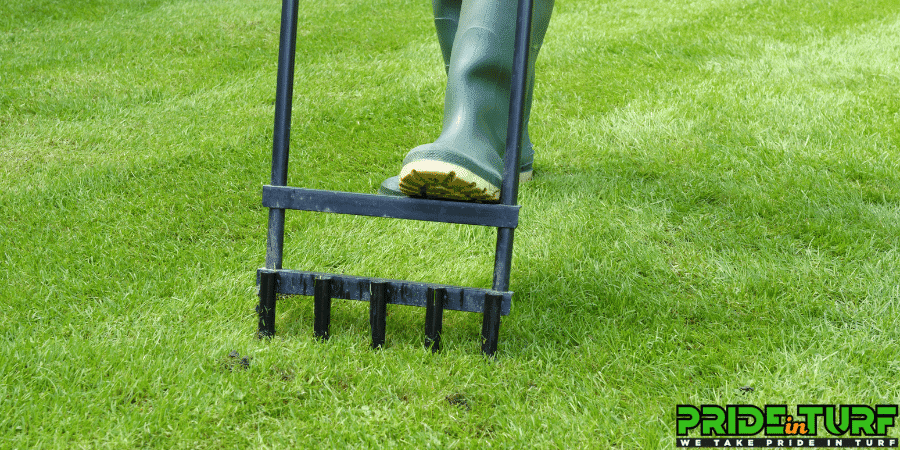If you live in Georgia or another southern state, you can count on the appearance of fire ant mounds in the year's late spring. To be such tiny little pests, ants can cause a lot of turmoil in home lawns, hayfields, and pastures. They are one of the most detested insects. Many people are stung […]

Unfortunately, your lawn can have both thatch and compaction problems. You may need both if your lawn has spongy brown carpet and rock-hard soil. You will only need to dethatch your lawn if the thatch becomes an issue. As long as the thatch layer stays thin, nutrients can reach the soil, and the grass will grow thick and healthy. A thin layer of thatch fits your lawn as it provides nutrients for earthworms and beneficial microbes. It also insulates the soil during extreme temperature shifts. Thick thatch (over ½ inch long) acts as a barrier against sunlight, water, oxygen, and nutrients, and this will diminish soil quality and stifles root growth. Compacted soil also restricts root growth and does not give roots space to receive water, oxygen, and nutrients from the soil surface. This is when you need aeration.
The difference between Dethatching and Aerating
Dethatching is vigorously raking up excel thatch, a layer of dead grass, leaves, and other organic matter between grass blades and the soil surface). Dethatching gives the soil and grassroots access to water, oxygen, sunlight, and nutrients. Aeration loosens lawn soil and fixes problems with compaction (or gives your ground more air). Core aeration (or plug aeration) involves poking out small cores of soil from your lawn to relieve soil compaction. This gives roots the space to grow and increases the flow of nutrients, water, and oxygen to the roots allowing the ideal time to fertilize your lawn.
Knowing When Your Lawn Needs Dethatching or Aerating
It can be difficult to know if your lawn needs dethatching, aeration, or both. You can do some tests on your own to determine what is required.
How to know if your lawn needs dethatching: Measure your thatch as follows:
- Dig a 3-inch hole in your yard and remove a small slice of soil
- Measure the brown, spongy thatch layer between the grass blades and the soil surface
- If the thatch layer is over half an inch long, your lawn could use dethatching
How to know if your yard needs aeration: Shallow root depth is a strong indicator of soil compaction:
- Cut out a small section of lawn at least 6 inches deep
- Use a ruler to measure the length of your grassroots
- If grassroots are growing only 1 to 2 inches deep, your soil probably needs aeration
Signs Your Lawn Needs Dethatching or Aeration
| The lawn may need Dethatching if….. | The lawn may need Aeration if….. |
| The ground is spongy and springy to the touch | The soil feels hard to the touch |
| Grass blades are weak | The grass is thinning or developing diseases (like brown patches) |
| The grass is thinning, and dry spots are appearing | The lawn is not draining correctly during rainstorms |
| Weeds are invading | Weeds are invading |
| The grass is losing its healthy, green color | The grass is turning yellow |
| The lawn is developing an insect problem | The grass is growing slowly |
| The property is more sensitive to temperature extremes | Trees and shrubs are showing symptoms of stress (wilting, leaf scorch, early fall color, or dieback) |
| Fungal diseases are infecting your lawn |
Can you Dethatch and Aerate at the Same Time?
It can vary how often you need to dethatch or aerate your lawn. Some grasses may need annual treatments, whereas others may only need dethatching or aerating every few years. You can do both simultaneously; however, dethatching should come first. Dethatching removes the layer of thatch above the soil surface, blocking air, light, and water from reaching the roots. Aeration should be done right after dethatching. This removes plugs from the lawn, which helps the root system spread out and grow deeper into the soil. Combined, matching and then aerating will create the best results when both are needed.
Conclusion
As you can see from this information, symptoms of thick thatch and compacted soil can be pretty similar. There are tests to determine the needs of your lawn and which method is best – or when you may need both (as stated above). It is always a good idea to seek an excellent professional opinion for the best results. Professionals can provide the best information for the type of grass in your lawn and the best time to dethatch or aerate for the climate in your area. Knowing precisely what and when aeration is needed for your property will help you reach your goals and give you the lush, green lawn you desire— contact Pride In Turf for information from a trusted lawn aeration professional.
